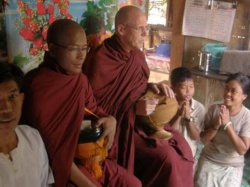Nalanda and other Buddhist universities in ancient India
By Y. SATYA SREE
India has a glorious past with rich cultural heritage. Education had become a powerful tool in the preservation and transmission of this culture in ancient India. The aims of education depended on the country’s philosophy of life. To quote Prof. Ross “
Education and Philosophy are the two sides of the same coin.” Particularly the Buddhist philosophy has contributed a great deal to the educational thought and practice in ancient India.
Long before western universities came into existence many universities which were the reputed seats of Higher Learning were established and patronized by enlightened kings of India who embraced Buddhism. Primarily these Buddhist Viharas or monasteries
were set up with the sole aim of propagating Buddhism. They followed their own methods in the initiation and training of the Buddhist monks. But ere long, they developed into full - fledged Universities offering courses in various subjects of Arts, Philosophy,
Literature, Medicine, Grammar and Vocational skills.
Takshasila functioned from the seventh to the third century B.C. Many students from all over India came to this seat of advanced learning. The students entered the university at the age of sixteen and stayed there till the completion of the course.
Different subjects of Arts and Sciences were taught. The collection of fees depended on the financial position of the student ranged from 500 to 1000 kahapanas. In imparting instruction no discrimination was shown between the rich and the poor. They had large classes
in certain subjects with a strength of 500 students. Quite often, the brilliant alumni of the university assisted the teachers as deputy teachers. After completing the course, the students had to go round the country to gain practical experience and on their return
home, they could eke out their livelihood.
Vauabhi, the cenfre of Higher Learning, was established by Gunamati and Sthiramati and was patronized by the Maitraka Kings of Saurashtra. King Dharmapahi of the [[Wikipedia:Pala dynasty (Kamarupa)|Pala dynasty)] of Bengal was the founder of Vikramasila University. In the middle of the eighth
century A. D., the University of Odantapuri was established under the patronage of the same Pala dynasty. The last of its kind in these great universities was Jagaddala built by the king Ramapala of Bengal. It existed only for a century and was destroyed by foreign
invaders as it happened in the case of all other Buddhist universities.
Nalanda was the most prestigious university of that period. It functioned from 500 A.D. till the thirteenth century A.D. Since it was basically a Mahayana Buddhist University, all the students were Buddhist monks. There was always a great rush and demand
for admission into this University. The rules of admission were very strict and admission was made on the basis of a test. The test was so difficult that only 20% of the students could pass and the rest were denied admission. For the students seeking admission in
certain subjects, scholarly teachers who stood at the entry points (gates) used to put searching questions. Those who failed to answer them had to retire in disappointment.
The whole university which consisted of spacious dormitories, lecture - halls and libraries was enclosed by a compound wall of brick. The well-stocked library was located in three buildings called Ratnaranjaka, Ratnasagara and Ratnodadhi. Ratnodadhi was
a multi-storeyed building. The entire set of these three great libraries was known as Dharmaganja.
The University worked as a corporate body. The head of the University was called Kulapati. The ‘Seal’ of Nalanda which contained the figure of ‘Dharmachakra’ was considered to be very prestigious. Teachers of outstanding merit like Nagarjuna,
Silabhadra, Aryadeva, Jinamitra, Gunamati, Sthiramati and Jnanachandra taught in this great University. As many as 10,000 students and teachers lived in the campus. The teachers guided the students both intellectually and spiritually which formed the basis for their
character development and moral discipline.
The teachers followed oral methods of instruction including discussions, repetition, criticizing, preaching, exposition, debates, lectures and tutorials. Major issues were discussed in Seminars and Goshtis organised by the Buddhist Council. They felt
that the day was too short for them to carry on these wise discourses. Mahayana and other schools of Buddhism, Samkhya, Nyaya, Tantra, Logic, Astronomy, Yoga, Philosophy, Literature, Grammar and Medicine were the subjects taught there. They were also trained in
vocational skills like Spinning, weaving, carpentry, pottery and smithery.
Though Nalanda was established primarily with a view to propagating Buddhism, it always encouraged democratic freedom of enquiry. It was never sectarian in its approach. It received financial support from several kings. They donated huge sums of money,
property and land for its maintenance. The University had its own agricultural fields and dairy farms to meet the daily requirements of rice and milk for students and the faculty.
All these Buddhist universities, played a significant role in preserving and transmitting culture in ancient India. They attracted students from all over India and also from the neighbouring countries like Korea, Japan, Tibet, China, Mangolia and Ceylon.
They encourage excellent cross-cultural contacts. The teachers functioned as missionaries spreading Buddhist culture abroad. These missionaries have done a commendable job in translating Indian literature into Chinese and Tibetan and thus put it on the world stage.
Thus, these great Buddhist universities functioned as agencies of education and cultural transmission. Chinese travellers like Fahien, ITsing and Hiuen Tsang who visited the institution wrote in their diaries about those universities creating the
impression that Nalanda University was a model of excellence in those days.
References:
1. Altekar, A.S. Education in Ancient India.
2. Bose. P. N., Indian Teachers of Buddhist Universities.
3. Mookerji, R. K. Ancient Indian Education.
Life, liberty and the pursuit of happiness are constitutionally guaranteed. But if life hardly seems worth living, if liberty is used for subhuman purposes, if the pursuers of happiness know nothing of their quarry, these constitutional rights will not be very meaningful. An education in that wise passiveness is recommended by saints and poets and by all who lived fully and creatively.”



